"The world meets in Pärnu", slogan for the 14th festival in Estonia's summer seaside capital, has held good ever since Paavo Järvi gathered native musicians and key players from the international teams he inspires to form what's now the Estonian Festival Orchestra. Buzz about the youngsters formerly serving just the conductors’ course is new; 2024's Järvi Academy Youth Symphony Orchestra embraces 30 countries.
So it was that the youngest member, 11-year-old Armenian cellist Aren Toplaghaltsian, got to play his first Beethoven symphony under 87-year old Neeme Järvi, a living legend (young Aren rewarded the honour by memorising the repertoire). A regular observed that the patriarch seems to be moving backwards in time. He certainly seemed younger than last year, when the charismatic gestures weren't quite so energetically threaded. A few days' acquaintance with the young people seemed part of the revitalisation; they gave their first concert together for the opening of the festival last Wednesday (pictured below by Tõiv Jõul).
Total focus and consummate technique in Beethoven One included emphasis on individual notes within phrases, resulting in perfect articulation from the phenomenally good strings. The crowning glory was the ultimate playfulness as Beethoven goes up the scale, adding a note each time, at the start of the finale (you can see it for yourselves on the marvellous Pärnu Music Festival TV channel here at 28m21s. The service features all events from the past three years to watch for free at any time). 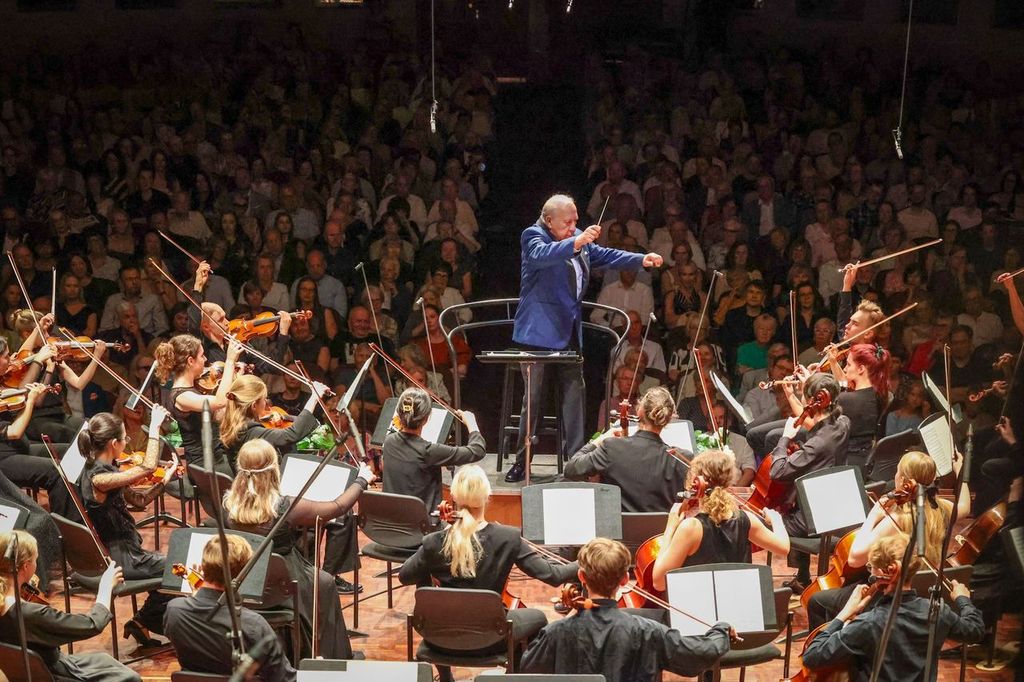 Many of Järvi Senior's tempi have become brisker over the years, and that was true of a Schubert "Unfinished" Symphony shorn of indulgent pathos. For this the veteran donned spectacles and used his seat more often, but there was no shortage of finesse, and those linking phrases on the brink of audibility in the Andante con moto were as controlled and atmospheric as any you'd hear from a great orchestra.
Many of Järvi Senior's tempi have become brisker over the years, and that was true of a Schubert "Unfinished" Symphony shorn of indulgent pathos. For this the veteran donned spectacles and used his seat more often, but there was no shortage of finesse, and those linking phrases on the brink of audibility in the Andante con moto were as controlled and atmospheric as any you'd hear from a great orchestra.
The big surprise was the total success of the Järvi encore. A slight inward groaning at the prospect of Albinoni's Adagio in the Giazotto arrangement with organ turned to emotional delight at the floating pace Järvi chose for it, the supple string phrasing, the almost overwhelming full-bodied ritornello in what became an aria for orchestra. One to add to the list of transformational NJ treasures. Whether we wanted to hear again nearly two whole movements of Friedrich Gulda's Concerto for Cello and Wind Orchestra, the second-half rarity, was a different matter. 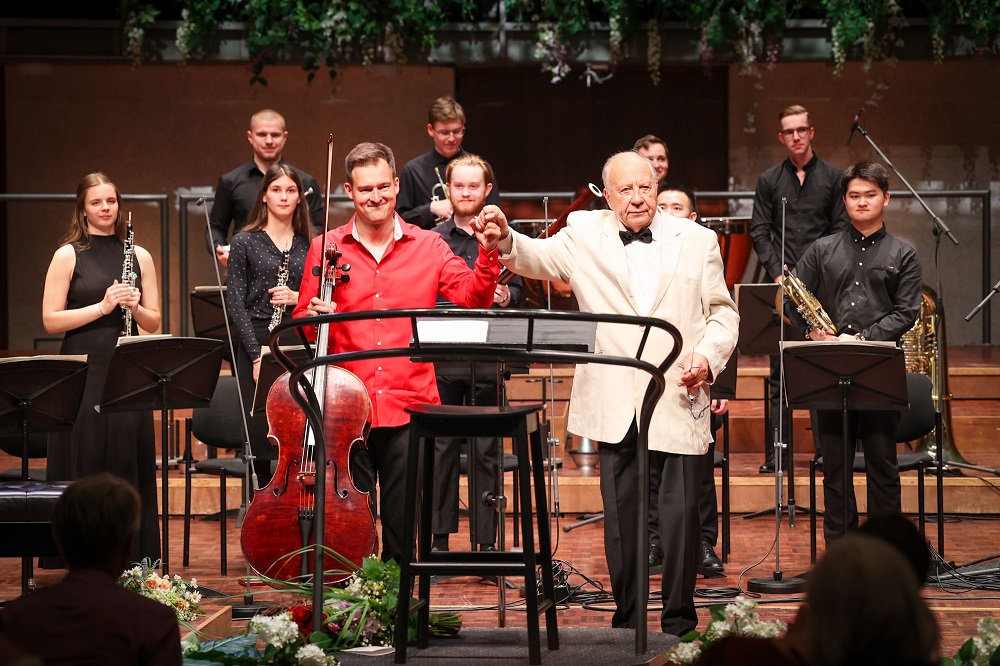 The conductor clearly loves it, and Gulda's eclectic mix of styles, from jazz to schrammel, minuet, chorale and band music, would have given the smaller group of young players valuable experience in the various genres. But the results are little more than pastiche, not connecting to the darker undertow of the semi-improvised cadenza, superbly played, like the rest, by an Estonian cellist I haven't knowingly encountered before despite his very distinguished CV, the very personable Indrek Leivategija (pictured above by Tõiv Jõul with Järvi and the players).
The conductor clearly loves it, and Gulda's eclectic mix of styles, from jazz to schrammel, minuet, chorale and band music, would have given the smaller group of young players valuable experience in the various genres. But the results are little more than pastiche, not connecting to the darker undertow of the semi-improvised cadenza, superbly played, like the rest, by an Estonian cellist I haven't knowingly encountered before despite his very distinguished CV, the very personable Indrek Leivategija (pictured above by Tõiv Jõul with Järvi and the players).
The youth orchestra is playing for this year's successful applicants on the Academy course tonight, as I write; I witnessed 10 of the young conductors working with an expert group, the Järvi Academy Sinfonietta, at its heart the players of the superb Tallinn Chamber Orchestra, in two more classic symphonies – Haydn's No. 94. "Surprise", and Mozart's No. 39. The programme was skilfully sequenced with two works by Arvo Pärt at the beginning of each half: the short but utterly distinctive Psalom and L'abbé Agathon, a mini-opera about the meeting of the titular desert father with a leper who reveals himself as one of God's angels, originally premiered in Beauvais by Barbara Hendricks and eight cellos. 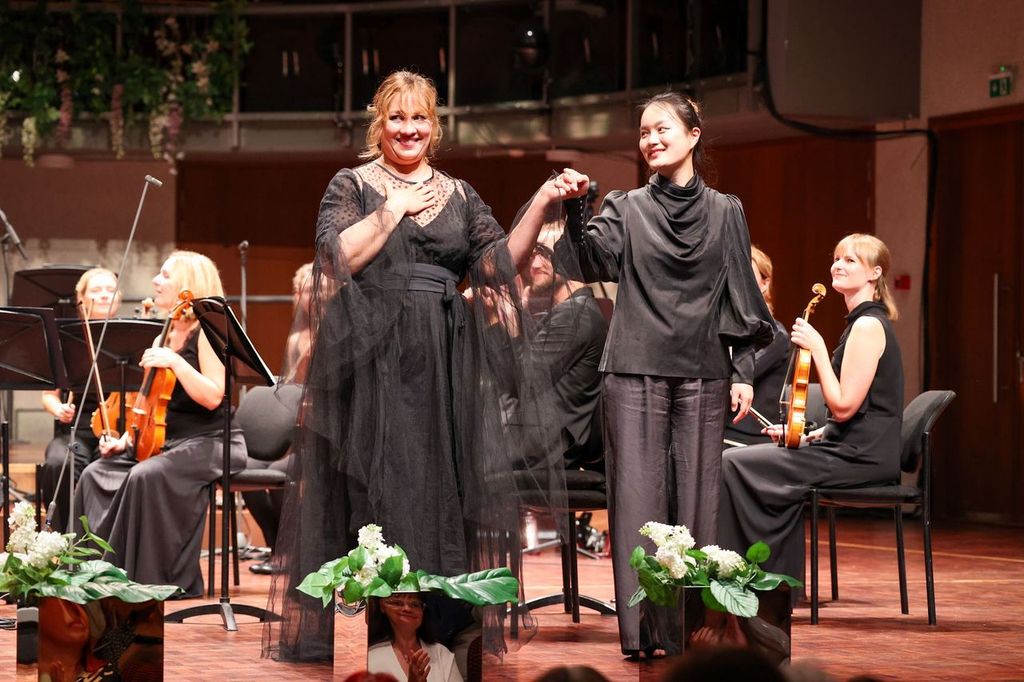 This version arranged for string orchestra showcased the singular artistry of Tuuri Dede (pictured above byTõiv Jõul with Mengru Zhen), whose ability to open out to fullest tones in a leap from low register to high produced a stunning climax; but alas, not a word of the French could be made out, and in Pärnu we lacked the translation projected on to the back wall of the glorious Arvo Pärt Centre in an earlier performance.
This version arranged for string orchestra showcased the singular artistry of Tuuri Dede (pictured above byTõiv Jõul with Mengru Zhen), whose ability to open out to fullest tones in a leap from low register to high produced a stunning climax; but alas, not a word of the French could be made out, and in Pärnu we lacked the translation projected on to the back wall of the glorious Arvo Pärt Centre in an earlier performance.
Pärt's later style requires steadiness and a nose for atmosphere, not the most demonstrative of qualities in a conductor; and so the eight taking a movement each of the Haydn and Mozart symphonies could be better judged, up to a point. Even here the difference in ages and experience should ward one off preferences. What I will say is that several of the younger candidates need to loosen up physically – easier said than done when you're facing a full audience and a top group of instrumentalists – and that the standouts were Julia Kurzydlak and Alec Frank-Gemmill. His track record as one of the great horn players – a stalwart of the Estonian Festival Orchestra, among others – has given him certain collegial advantages, and his manner is engaging; sitting at the side, it was easiest to observe how much each conductor inclined to first violins left and seconds right, and in this Frank-Gemmill was most flexible. (Pictured below by Tõiv Jõul: the 10 conductors at the end of the concert with mentors Paavo Järvi, left, and Leonid Grin, fourth from left).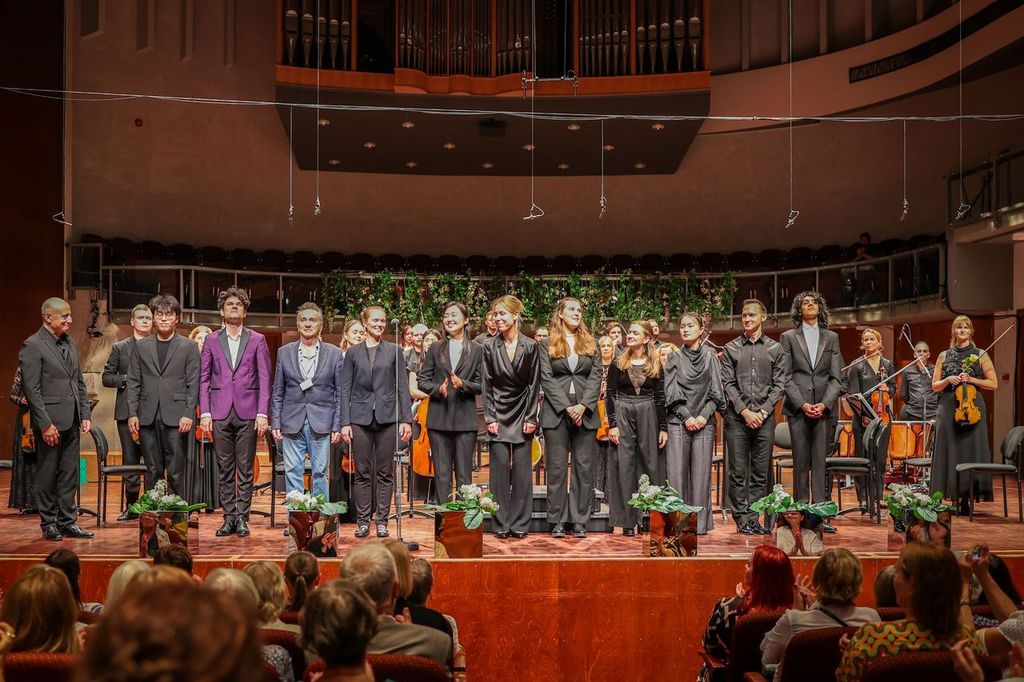 I also watched on the TV channel the earlier concert in Tallinn's St John's Church, where Frank-Gemmill was given Mozart's first movement rather than his Minuet to conduct; here the felicitous touches were infinite. This was also my only chance to observe the progress of Kasper Joel Nõgene, 15 at the time of his first performances on the course, now 17; his performance of the Mozart finale seemed to cover most expressive bases impressively.
I also watched on the TV channel the earlier concert in Tallinn's St John's Church, where Frank-Gemmill was given Mozart's first movement rather than his Minuet to conduct; here the felicitous touches were infinite. This was also my only chance to observe the progress of Kasper Joel Nõgene, 15 at the time of his first performances on the course, now 17; his performance of the Mozart finale seemed to cover most expressive bases impressively.
It's easy to forget Kristjan Järvi's credentials as a serious conductor – and a superb trainer of the young, as I've witnessed previously in Pärnu – when watching his antics at one of his happenings, a major contrast to what's going on in the other 16 festival concerts. Last year's event was a spectacular presentation of the music to one of the best TV dramas ever, Babylon Berlin, in which KJ had a major input, and came up to the four series' mark in both visual and aural style. These things take time to put together, and this year's programme, Nordic Swans, subject to much havering, lacked proper rehearsal time (much of it went on a new work by Rein Rannap, only part of a continuous programme which featured maybe too many of KJ's own pieces in the Glass/Richter vein). 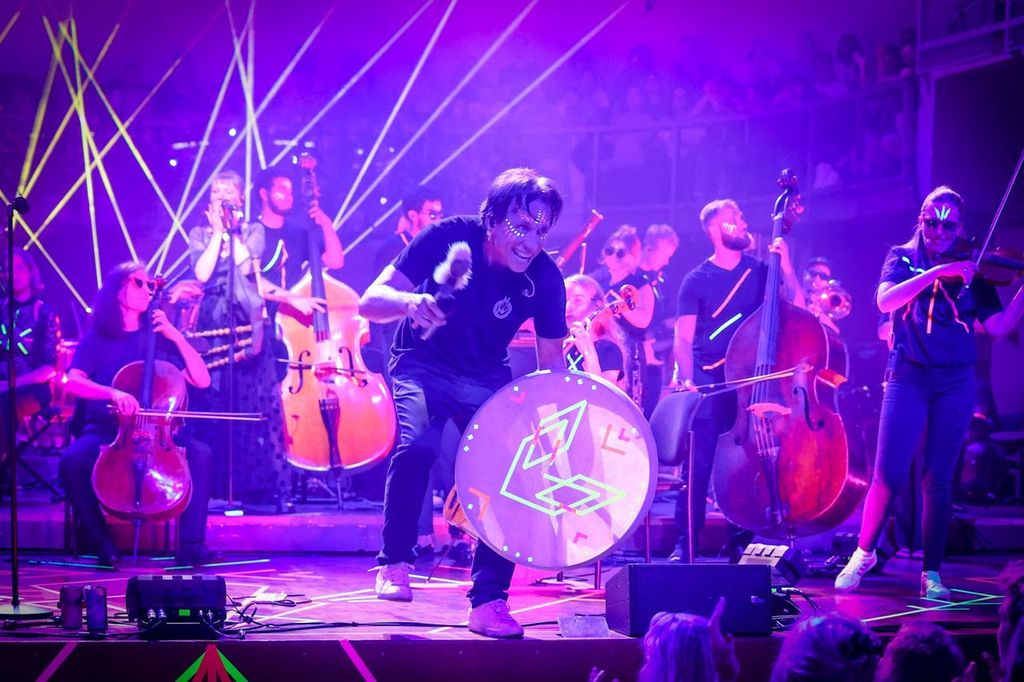 There's no doubt that Kristjan (pictured above byTõiv Jõul) believes in what he does, and standard performances could take a leaf or two out of the general communicative vibe, but not all the players of the former Baltic Sea Philharmonic are happy to have been rebranded as the Nordic Pulse Orchestra, which means leaving the classical repertoire behind. Predominantly simple ideas – even in 5/4 time – along with random lighting changes/old-hat lasers and naff fluorescent face paint made this feel like an end-of-term school concert. Maybe there should have been collaboration with local teenagers to validate it. Anyway, the band played on the next night at the Beach Grind Festival closer to the water's edge, and that might have gone down better – though the Pärnu Concert Hall was packed.
There's no doubt that Kristjan (pictured above byTõiv Jõul) believes in what he does, and standard performances could take a leaf or two out of the general communicative vibe, but not all the players of the former Baltic Sea Philharmonic are happy to have been rebranded as the Nordic Pulse Orchestra, which means leaving the classical repertoire behind. Predominantly simple ideas – even in 5/4 time – along with random lighting changes/old-hat lasers and naff fluorescent face paint made this feel like an end-of-term school concert. Maybe there should have been collaboration with local teenagers to validate it. Anyway, the band played on the next night at the Beach Grind Festival closer to the water's edge, and that might have gone down better – though the Pärnu Concert Hall was packed.
As it was for the first of the four annual concerts people travel from far away to hear, featuring older brother Paavo's already legendary Estonian Festival Orchestra. The constitution changes according to who's available, and I missed some familiar old faces – though it was grand to see top bassoonist Amy Harman back in Pärnu after a decade. She'd been on the tour earlier this year, and another member of the orchestra felt that the really unique quality of only meeting for a couple of weeks in the summer might have been lost as the EFO takes its high style around the world. (Pictured below by Kaupo Kikkas: Paavo Järvi in rehearsal).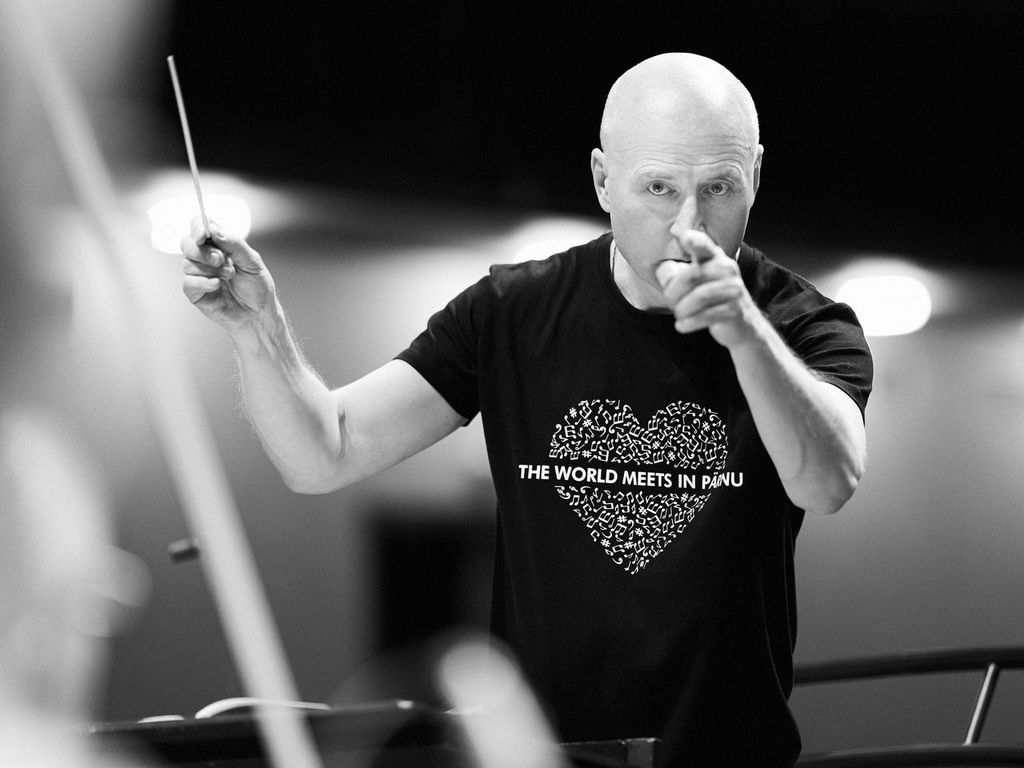 Yet the spark was unmistakably there. The slight problem I had this year was in the choice of repertoire: nothing to leap out as the highest-level festival fare like previous experiences of Shostakovich's Sixth Symphony, Sibelius's Second and Fifth, Nielsen's First (a revelation) and Second, Lutosławski's Concerto for Orchestra, Lepo Sumera's Cello Concerto, Berlioz's Harold in Italy, even Berwald's "Sinfonie Naive"... It may well be that Paavo Järvi works wonders on Mendelssohn's admirable Third ("Scottish") Symphony in the last two concerts still to come, but Andris Nelsons chose that for his inauguration with the Leipzig Gewandhaus Orchestra and it didn't quite set the pulse racing. The best option in choosing which half of the festival to catch seemed to be to go for the rarities of the first programme: an Estonian premiere and Bizet's Roma Symphony, which I've never heard in concert before (who has?)
Yet the spark was unmistakably there. The slight problem I had this year was in the choice of repertoire: nothing to leap out as the highest-level festival fare like previous experiences of Shostakovich's Sixth Symphony, Sibelius's Second and Fifth, Nielsen's First (a revelation) and Second, Lutosławski's Concerto for Orchestra, Lepo Sumera's Cello Concerto, Berlioz's Harold in Italy, even Berwald's "Sinfonie Naive"... It may well be that Paavo Järvi works wonders on Mendelssohn's admirable Third ("Scottish") Symphony in the last two concerts still to come, but Andris Nelsons chose that for his inauguration with the Leipzig Gewandhaus Orchestra and it didn't quite set the pulse racing. The best option in choosing which half of the festival to catch seemed to be to go for the rarities of the first programme: an Estonian premiere and Bizet's Roma Symphony, which I've never heard in concert before (who has?)
In the event, the contrasts between first and second halves didn't quite come off, given a lack of a wow factor of any kind. The first offered two attractive Estonian works and a spellbinding arrangement of Latvian Pēteris Vasks' The Fruit of Silence by George Morton for accordion, vibraphone and strings, which would have come as special encore balm after a tumultuous symphonic finale; but it was all too much on the soporific side, starting in subdued fashion with Ester Mägi's Vesper (why not the more variegated The Sea, which I'm proud to have championed with Jonathan Bloxham and the Northern Chords Festival Orchestra at a Europe Day Concert?) 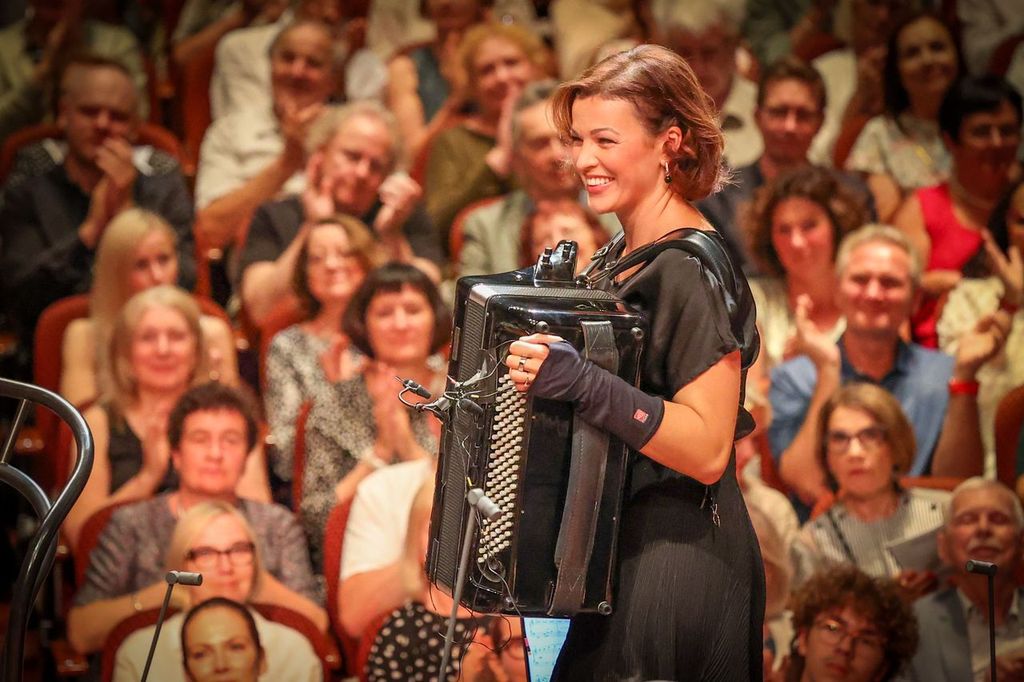 In the previous day's rehearsal, true artist Ksenija Sidorova, the Latvian accordionist (pictured above by Tõiv Jõul), and the EFO made me fully realise me what an amazing, intricate work is Erkki-Sven Tüür's Prophecy Concerto, as I hadn't to the same degree at its Latvian performance by the same team seven years earlier.
In the previous day's rehearsal, true artist Ksenija Sidorova, the Latvian accordionist (pictured above by Tõiv Jõul), and the EFO made me fully realise me what an amazing, intricate work is Erkki-Sven Tüür's Prophecy Concerto, as I hadn't to the same degree at its Latvian performance by the same team seven years earlier.
This wasn't the work in the current concert, though – it was being prepared for a Monday recording session – and instead we heard the world premiere of Tõnu Kõrvits's Accordion Concerto Dances. Kõrvits is a post-romantic poet; To the Moonlight in 2020, at a festival we never thought would happen, bewitched, and there were moments here which did too, above all some gorgeous chord progressions and accordion response in the third-movement Siciliana. But once past the opening cadenza, Sidorova compelling as always, the drift felt too amorphous, the romanticism too film-score-y at times. The Vasks arrangement said more with less. 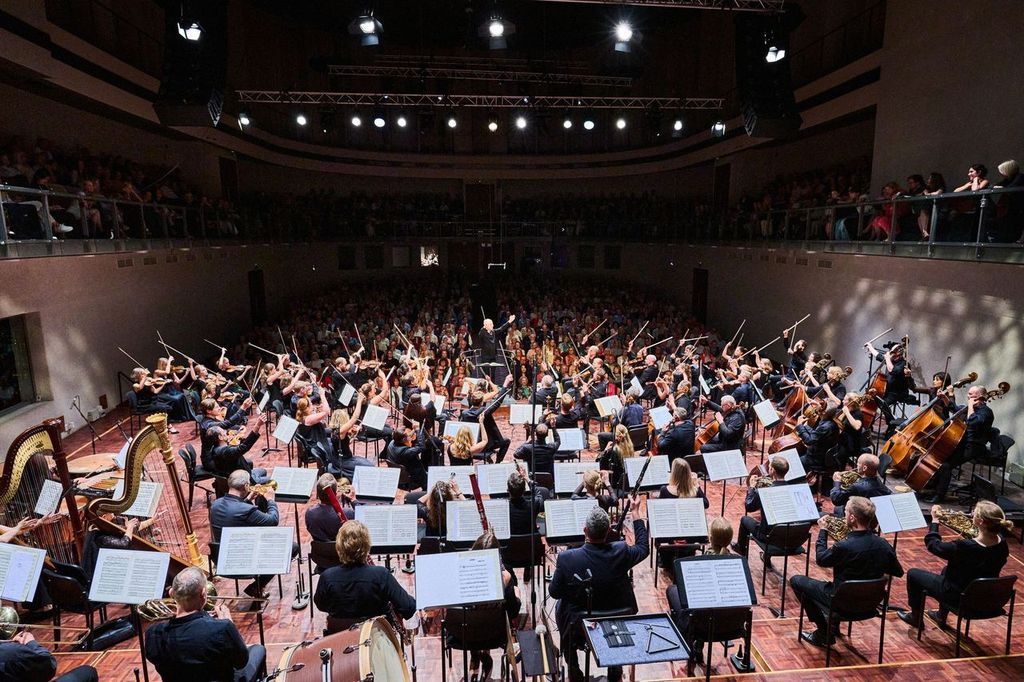 The big question still hung at the interval: would Bizet's Roma, abundant in melody and often in the orchestration which is a constant cause for wonder throughout Carmen, make more of an impact than merely as the representative of what Tchaikovsky called "le joli", "the pretty", in French music? Rodomontade is not Bizet's strong suit, and the powerful muscle which Järvi and the EFO (pictured above by Kaupo Kikkas) can bring to bear only made the fraught rite of passage in the first movement seem less than the real thing. Horn ensemble, marvellous; string fugato in the brilliant scherzo, striking but a little too free perhaps; wind solos in the lovely Andante molto, perfection; high spirits in the tarantella finale picking up on the big tune exactly what we expect from this electrifying partnership.
The big question still hung at the interval: would Bizet's Roma, abundant in melody and often in the orchestration which is a constant cause for wonder throughout Carmen, make more of an impact than merely as the representative of what Tchaikovsky called "le joli", "the pretty", in French music? Rodomontade is not Bizet's strong suit, and the powerful muscle which Järvi and the EFO (pictured above by Kaupo Kikkas) can bring to bear only made the fraught rite of passage in the first movement seem less than the real thing. Horn ensemble, marvellous; string fugato in the brilliant scherzo, striking but a little too free perhaps; wind solos in the lovely Andante molto, perfection; high spirits in the tarantella finale picking up on the big tune exactly what we expect from this electrifying partnership.
As a festival showpiece, though, it still wasn't quite enough, much as the orchestra clearly loved playing it. The encores were peerless: , a hyper-brilliant and focused Carmen Prelude, and exquisite poetry in the second of Svendsen's Two Swedish Folk Melodies, cued like so much other music at Pärnu by the example of father Neeme. Yet greedily, I wanted more. Returning home, I caught on screen the recent LSO concert in Trafalgar Square, engagingly conducted by rising star Duncan Ward. That's how to programme a festive event: begin with "le joli" in the shape of Chabrier's Joyeuse Marche, continue with a heady mix and end with Stravinsky's Petrushka (what a concerto for Pärnu's army of generals that would make).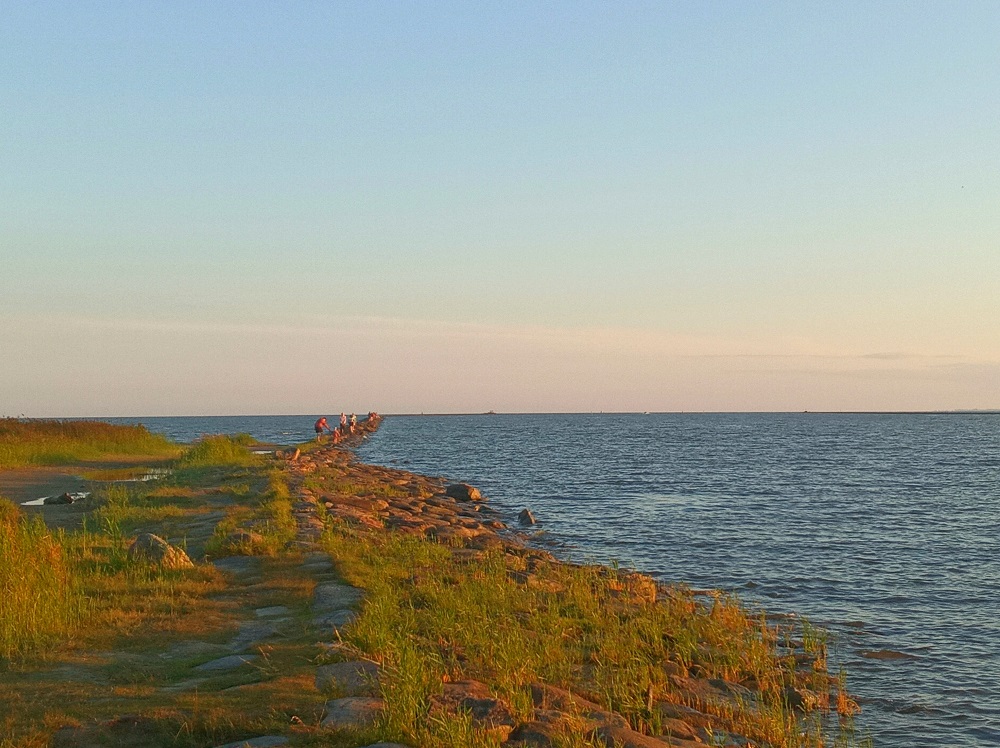 If that sounds ungrateful, I'm not – I love this place and the atmosphere of warmth that Paavo engenders between players and visitors as much as ever; typified by post concert gatherings at the Passion Cafe. I was more thankful than ever for time in the nature reserves on the coast, watching terns hovering and plunging, picking up the songs of reed and snow bunting, reed warbler, golden oriole, redshank, green sandpiper (pictured above: looking towards the stone jetty at the mouth of the Pärnu River near sunset). And the musical pleasure can continue in watching on the festival television channel what I couldn't stay on to see live, chiefly the always sensational chamber concert from star players and the final Academy event, where Dvořák's Seventh Symphony is the chance to go deep that the EFO didn't get this year. But in terms of performance, nothing has dropped from the highest standards of execution and infectious joy in music-making.
If that sounds ungrateful, I'm not – I love this place and the atmosphere of warmth that Paavo engenders between players and visitors as much as ever; typified by post concert gatherings at the Passion Cafe. I was more thankful than ever for time in the nature reserves on the coast, watching terns hovering and plunging, picking up the songs of reed and snow bunting, reed warbler, golden oriole, redshank, green sandpiper (pictured above: looking towards the stone jetty at the mouth of the Pärnu River near sunset). And the musical pleasure can continue in watching on the festival television channel what I couldn't stay on to see live, chiefly the always sensational chamber concert from star players and the final Academy event, where Dvořák's Seventh Symphony is the chance to go deep that the EFO didn't get this year. But in terms of performance, nothing has dropped from the highest standards of execution and infectious joy in music-making.
- The festival ends tomorrow, Friday 19 July. You can watch every concert any time for free on Pärnu Music Festival TV
- More classical music reviews on the arts desk

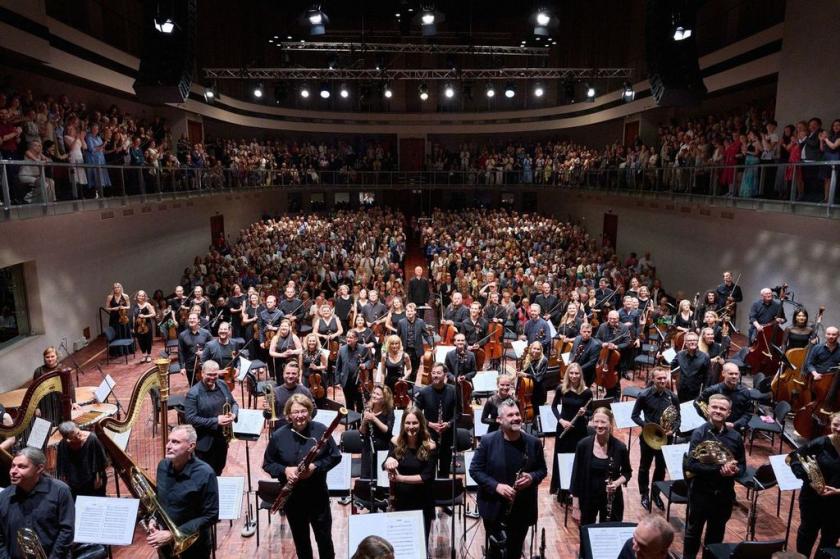


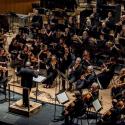
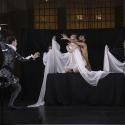
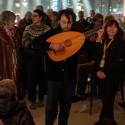
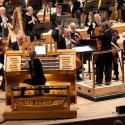






Add comment